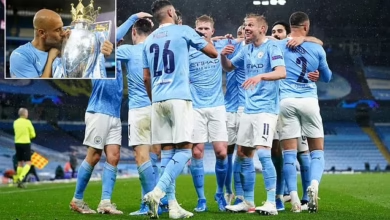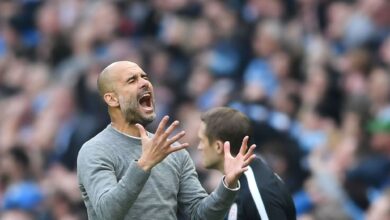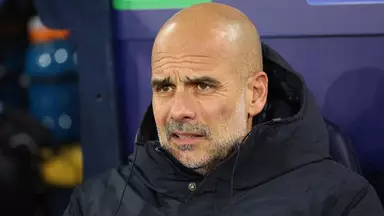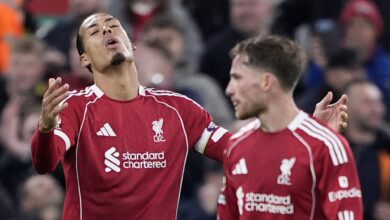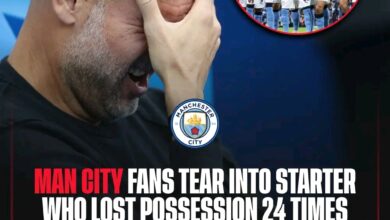Tough 24/25 season now sees Man City defender sent on loan to another English club

The 2025 summer transfer window has proven to be one of the most significant periods of change for Manchester City in recent years. Following what can only be described as a challenging 2024/25 season, the club finds itself at a crossroads, with substantial modifications being made both to the first team squad and the academy setup. The latest development sees young defender Finley Burns joining Reading on loan, marking another chapter in the ongoing evolution of Pep Guardiola’s empire.
This comprehensive analysis examines the implications of Burns’ loan move, the broader context of Manchester City’s summer activities, and the mounting concerns surrounding the club’s ability to reclaim the Premier League title from Liverpool, particularly with Arsenal potentially strengthening their attack with Viktor Gyokeres.
Manchester City’s Ambitious Summer Transfer Strategy
The Four-to-Five Player Target
Manchester City entered the 2025 summer transfer window with clear objectives. The club’s hierarchy, led by Hugo Viana, identified the need to add four to five new faces to the squad—a target that has been successfully achieved with the acquisition of Tijjani Reijnders ahead of the FIFA Club World Cup. This strategic approach demonstrates the club’s commitment to continuous improvement and adaptation, recognizing that even elite squads require regular refreshing to maintain their competitive edge.
The decision to target multiple signings reflects the lessons learned from the challenging 2024/25 campaign. Manchester City’s management recognized that certain areas of the squad needed strengthening, and the systematic approach to recruitment suggests a well-planned strategy rather than reactive purchases. The timing of these acquisitions, particularly before the FIFA Club World Cup, indicates the club’s intention to integrate new players early and build chemistry within the squad.
Coaching Staff Reinforcement
Beyond player acquisitions, Manchester City has also strengthened their coaching infrastructure. The appointments of Pepijn Lijnders and James French to Pep Guardiola’s coaching staff represent a significant investment in the technical aspects of the game. These additions have reportedly been well-received by the current squad, suggesting that the changes are not merely cosmetic but represent genuine improvements to the club’s operational efficiency.
Lijnders, with his extensive experience and tactical acumen, brings fresh perspectives to Guardiola’s already sophisticated system. His previous work and coaching philosophy align well with Manchester City’s playing style, making him an ideal addition to the staff. French’s appointment complements this technical expertise, providing additional depth to the coaching structure and ensuring that all aspects of player development and tactical preparation are covered comprehensively.
The Finley Burns Situation: A Case Study in Modern Football Development
Early Promise and Development Path
Finley Burns’ journey at Manchester City represents both the potential and the challenges inherent in modern football development. Having joined the club’s academy from Southend United at just 13 years old, Burns has spent the formative years of his career within the City system. His development trajectory seemed promising, culminating in his first-team debut in 2021 during a memorable 6-1 victory over Wycombe Wanderers in the EFL Cup third round.
That debut appearance, where Burns played the entire match, marked a significant milestone in his career. The comprehensive nature of the victory and his complete performance suggested that the young defender had successfully adapted to the demands of senior football. For many observers, this debut represented the potential for Burns to follow in the footsteps of other academy graduates who have made successful transitions to the first team.
The Loan System Strategy
Manchester City’s approach to player development through the loan system has been a cornerstone of their youth strategy. Burns’ loan spells at Swansea City, Stevenage, and Hull City were designed to provide him with the regular first-team football necessary for his continued development. Each loan move was carefully selected to provide different types of experience and challenges.
The loan to Swansea City in 2022 represented his first significant step into senior football. The Welsh club’s playing style, which Burns himself noted was similar to Manchester City’s approach, provided an ideal environment for his development. His comments upon joining Swansea revealed his confidence and optimism about his future prospects: “I think I’ve been prepared the best I could have possibly been because of my work with Pep and the youth coaches at Man City.”
Injury Setbacks and Career Challenges
However, Burns’ development trajectory faced significant obstacles during his time at Hull City. The 2024/25 season proved particularly challenging, with injuries limiting him to just 11 appearances across all competitions. This injury-plagued campaign represented a crucial setback in his development, occurring at a time when consistency and regular playing time were essential for his progression.
The impact of these injuries cannot be understated. At 22 years old, Burns is at a critical juncture in his career where he needs to demonstrate his ability to perform consistently at a high level. The limited game time due to injury has created a gap in his development that may prove difficult to overcome, particularly given the high standards expected at Manchester City.
Reading FC: The Next Chapter
The League One Challenge
Burns’ move to Reading FC represents both an opportunity and a potential last chance to revitalize his career trajectory. League One, while a lower division than his previous loan destinations, offers the possibility of regular first-team football and the chance to rebuild his confidence and match fitness following his injury-plagued season.
Reading’s decision to secure Burns on loan suggests they see significant potential in the young defender. The club’s faith in his abilities, despite his recent injury problems, indicates that his fundamental skills and tactical understanding remain intact. For Reading, acquiring a player with Premier League experience and Manchester City’s development background represents a significant coup.
Development Opportunities and Expectations
The loan move to Reading provides Burns with several key opportunities that could prove crucial for his future career. First, the expectation of regular first-team football should help him regain match fitness and confidence. Second, the responsibility of being a key player at Reading, rather than a squad player on loan, could accelerate his development and leadership qualities.
However, the pressure is also significant. At 22, turning 23 next year, Burns is approaching an age where he must demonstrate his ability to perform consistently at a level that justifies Manchester City’s continued investment in his development. The loan spell at Reading represents what may be his final opportunity to prove himself worthy of a future at the Etihad Stadium.
The Academy Exodus and Influx
Strategic Reshaping
Burns’ loan move is part of a broader restructuring of Manchester City’s academy system. The recent acquisition of Jeremiah Adesina, along with several other young stars from Premier League rivals, demonstrates the club’s continued commitment to youth development while also suggesting a more strategic approach to recruitment.
This pattern of simultaneous incomings and outgoings reflects the modern reality of elite football academies. Manchester City’s ability to attract young talent from rival clubs speaks to the reputation of their development system and the opportunities they can provide. However, it also creates increased competition for existing academy players like Burns, who must now compete not only with their peers but also with specially recruited talents.
The Challenges of Elite Youth Development
The Burns situation highlights the inherent challenges in elite youth development. While Manchester City’s academy has produced numerous successful players, the pathway from youth football to first-team regular remains extremely difficult. The club’s high standards and the quality of their first-team squad mean that only exceptional young players can make the transition successfully.
For players like Burns, who show promise but may not reach the exceptional level required for Manchester City’s first team, the loan system provides alternative pathways. However, as Burns’ situation demonstrates, these pathways are not guaranteed to lead to success, and external factors such as injuries can significantly impact development trajectories.
Manchester City’s Title Race Concerns
The Liverpool Challenge
Manchester City’s quest to reclaim the Premier League title from Liverpool represents one of the most significant challenges facing Pep Guardiola and his team. The 2024/25 season’s disappointments have highlighted areas where the club must improve, and the summer transfer activity reflects recognition of these deficiencies.
The challenge posed by Liverpool is multifaceted. Not only do they possess a squad capable of competing at the highest level, but they have also demonstrated the consistency and mentality required to win major titles. For Manchester City to reclaim their position at the top of English football, they must address both tactical and psychological aspects of their game.
Squad Composition Issues
The current Manchester City squad faces several significant challenges that have been exposed during recent competitions. The presence of what some observers term “deadwood” in the form of players like Jack Grealish and James McAtee, both of whom were notably absent from the FIFA Club World Cup squad, suggests internal recognition of squad quality issues.
Grealish’s situation is particularly concerning given his substantial transfer fee and the expectations that accompanied his arrival. His exclusion from key squads indicates that his integration into Guardiola’s system has not proceeded as hoped. Similarly, McAtee’s absence suggests that his development has not progressed to the level required for inclusion in Manchester City’s most important competitions.
Tactical Flexibility Concerns
The deployment of Matheus Nunes at right-back during the 4-3 defeat against Al Hilal highlights another area of concern for Manchester City. The necessity to play players out of position suggests either squad deficiencies or tactical inflexibility that could prove costly in competitive situations.
This positional flexibility, while sometimes necessary, can also indicate deeper issues within the squad structure. The fact that Nunes, a midfielder, was deployed at right-back suggests that Manchester City may lack adequate depth in certain positions, particularly in defense.
The Viktor Gyokeres Factor
Arsenal’s Potential Game-Changer
The potential signing of Viktor Gyokeres by Arsenal represents a significant threat to Manchester City’s title ambitions. The Swedish striker’s impressive record and his particular success against Manchester City in the UEFA Champions League make him a concerning addition to a rival squad.
Gyokeres’ hat-trick performance in Sporting CP’s 4-1 victory over Manchester City in the Champions League demonstrated his ability to perform at the highest level against elite opposition. His movement, finishing ability, and tactical awareness during that match suggested that he possesses the qualities necessary to succeed in the Premier League.
The £65 Million Investment
Arsenal’s reported £65 million investment in Gyokeres represents a significant statement of intent. This substantial fee demonstrates Arsenal’s commitment to challenging for major titles and their belief that Gyokeres can be the final piece in their tactical puzzle.
For Manchester City, this potential signing represents both a direct threat and an indication of the level of investment required to remain competitive. The fact that Arsenal are willing to invest such a substantial amount in a single player suggests that they view the upcoming season as a genuine opportunity to challenge for the Premier League title.
Tactical Implications
Gyokeres’ potential arrival at Arsenal could fundamentally alter the tactical dynamics of the Premier League title race. His physical presence, combined with his technical ability and goal-scoring record, would provide Arsenal with a focal point for their attacking play that they have previously lacked.
The striker’s ability to link play, create space for teammates, and convert chances could transform Arsenal’s attacking efficiency. For Manchester City, this would represent an additional challenge in their quest to reclaim the title, as they would face a more potent Arsenal attack capable of capitalizing on the chances they create.
The Broader Context: Manchester City’s Evolution
Pep Guardiola’s Legacy Concerns
The current situation at Manchester City occurs within the broader context of Pep Guardiola’s tenure and his legacy at the club. Having achieved unprecedented success during his time in Manchester, the recent challenges represent a test of his ability to rebuild and adapt his approach to new circumstances.
Guardiola’s track record suggests that he possesses the tactical acumen and leadership qualities necessary to address the current challenges. However, the combination of squad aging, increased competition, and the need for significant investment creates a complex situation that will test even his considerable abilities.
The Financial and Regulatory Environment
Manchester City’s approach to squad building and development must also be considered within the context of Financial Fair Play regulations and the broader regulatory environment in football. The club’s ability to invest in new players while maintaining compliance with these regulations requires careful planning and strategic decision-making.
The focus on youth development and the loan system represents one approach to building squad depth while managing financial constraints. However, as the Burns situation demonstrates, this approach carries inherent risks and does not guarantee success.
Future Implications and Conclusions
The Burns Precedent
Finley Burns’ loan move to Reading may seem like a minor story in the broader context of Manchester City’s summer activities, but it represents important themes about modern football development. His journey highlights both the opportunities and challenges inherent in elite youth development, and his future success or failure will provide valuable insights into the effectiveness of current development strategies.
For Burns personally, the loan spell at Reading represents a crucial opportunity to revitalize his career and demonstrate his potential value to Manchester City or other clubs. The pressure to perform will be significant, but the opportunity for regular first-team football provides the platform he needs to showcase his abilities.
Manchester City’s Title Prospects
The broader implications of Manchester City’s summer activities and the potential changes in their rivals’ squads create an intriguing dynamic for the upcoming season. The club’s ability to address their identified weaknesses while maintaining their tactical sophistication will be crucial to their success.
The potential acquisition of Viktor Gyokeres by Arsenal adds another layer of complexity to the title race. Manchester City must now consider not only their own improvements but also the enhanced capabilities of their rivals. This creates a situation where continuous improvement and adaptation are essential for success.
The Academy System’s Future
The ongoing changes within Manchester City’s academy system, exemplified by Burns’ loan move and the acquisition of new young talents, reflect the evolving nature of elite youth development. The club’s ability to balance the development of existing players with the recruitment of new talents will be crucial to their long-term success.
The success or failure of players like Burns will influence future academy strategies and provide valuable lessons about the most effective approaches to youth development. The loan system, while providing opportunities for experience, also carries risks that must be carefully managed.
Conclusion
The loan move of Finley Burns to Reading FC represents more than just a routine academy transaction. It embodies the broader challenges and opportunities facing Manchester City as they navigate a period of significant transition. The club’s ambitious summer transfer strategy, combined with the potential threats posed by rivals like Arsenal, creates a complex landscape that will test their ability to maintain their position at the summit of English football.
For Burns, the loan spell at Reading represents a crucial opportunity to demonstrate his development and potential contribution to Manchester City or establish himself as a valuable player for other clubs. His journey will be watched closely by academy coaches and young players alike, as it provides insights into the pathways available within elite football development systems.
The broader implications of Manchester City’s summer activities extend beyond individual player movements to encompass fundamental questions about squad building, tactical flexibility, and the club’s ability to adapt to changing circumstances. The success or failure of these initiatives will have lasting consequences for the club’s competitive position and their prospects for reclaiming the Premier League title.
As the new season approaches, the effectiveness of Manchester City’s strategic decisions will be tested against the highest level of competition. The loan move of Finley Burns, while perhaps a small part of this broader picture, represents the kind of calculated risk-taking that characterizes modern football development and the ongoing evolution of one of the world’s most successful football clubs.







